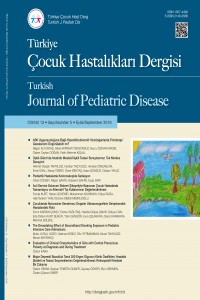Abstract
Loxosceles cinsi örümcekler, insanoğlunun yerleşim yerlerinde yaşayabilen, insanoğluna zarar verebilme potansiyeline sahip bir türdür. Literatürde örümcek ısırıklarına dair yapılan yayınlarda sistemik belirti ve bulgular nadiren bildirilmiştir. Sunacağımız olgu daha öncesinde sağlıklı olan dört aylık kız çocuğu olup huzursuzluk, boyunda şişlik, böcek ısırması şüphesi nedenleri ile başvurdu. Boyunda ve skalpte ödemi belirginleşen, solunum sıkıntısı olan ve şuuru bozulan olgu çocuk yoğun bakıma yatırıldı. Entübe edilen olguda koagülopati, dolaşım bozukluğu, CRP yüksekliği nedenleri amprik antibiyoterapi başlandı. Çadırda yaşadığı bildirilen olguya amprik olarak akrep serumu ve takibinde yılan serumu verildi. Olgunun ailesi yaşadıkları çadırda sonraki günlerde buldukları örümceği yoğun bakım ekibimize bildirdi ve ısırık bölgesine uyan bölgede dermonekroz gelişmiş olan olgunun tanısı aydınlatıldı. Dermonekroz debride edildi ve takibe alındı. Olgu bir aylık yatışı sonrasında dermonekroz haricinde belirgin sekel oluşmaksızın taburcu edildi. Literatürde nadiren bildirilmiş olan örümcek sokmasına bağlı şiddetli sistemik bulgular ve dermonekroz varlığı nedenleri ile vakamızı sunulmaya değer bulduk.
Keywords
References
- 1. Cesaretli Y, Özkan O. A clinical and epidemiological study on spider bites in Turkey. Asian Pac J Trop Med 2011;4:159-62.
- 2. Dyachenko P, Ziv M, Rozenman D. Epidemiological and clinical manifestations of patients hospitalized with brown recluse spider bite. J Eur Acad Dermatol Venereol 2006;20:1121–5.
- 3. Isbister GK, Gray MR. A prospective study of 750 definite spider bites, with expert spider identification. Q J Med 2002;95:723-31.
- 4. Diaz HJ. The global epidemiology, syndromic classification, management, and prevention of spider bites. Am J Trop Med Hyg 2004;71:239-50.
- 5. Gülalp B, Kayıpmaz AE, Altınörs MN, Sancak Z, Yiğit N. Loxosceles: A Case Healed Completely Without Any Necrotic Tissue by Emergency Department and Review of the Literature. JAEM 2013;12:101-4.
- 6. Akdeniz S, Green JA, Stoecker WV, Gomez HF, Keklikçi SU. Diagnosis of loxoscelism in two Turkish patients confirmed with an enzyme-linked immunosorbent assay (ELISA) and non-invasive tissue sampling. Dermatol Online J 2007;13:11.
- 7. Yiğit N, Bayram A, Ulaşoğlu D, Danışman T, Ocal IC, Sancak Z. Loxosceles Spider Bite in Turkey (Loxosceles rufescens, SICARIIDAE, ARANEAE). J Venom Anim Toxins incl Trop Dis 2008;14:178-87.
- 8. Dişel NR, Şahan Ö, Açıkalın A. Necrotizing arachnidism: Diagnosing with inspection in insect bites. Gaziantep Med J 2014;20:338-41.
- 9. Ergin Ş, Aktan Ş, Erdoğan BŞ, Kara İG, Evliyaoğlu D. Bir Nekrozitan Araknidizm Olgusu. Turkderm 2006;40:17-9.
- 10. Köse A, Çete Y, Eken C, Köse B. Loxosceles Isırığına Bağlı Gelişen Nekrotizan Araknidizm: Olgu Sunumu ve Literatürün Gözden Geçirilmesi. Türkiye Acil Tıp Dergisi 2006;6:181-5.
- 11. Taşkesen M, Akdeniz S, Taş T, Keklikçi U, Taş MA. A rare cause of severe periorbital edema and dermonecrotic ulcer of the eyelid in a child: brown recluse spider bite. Turk J Pediatr 2011;53:87-90.
- 12. Keklikçi U, Akdeniz S, Sakalar YB, Çakmak SS, Ünlü K. Loxosceles reclusa bite to the eyelid. Eur J Ophthalmol 2008;18:633-5.
- 13. Vetter RS, Bush SP. Additional considerations in presumptive brown recluse spider bites and dapsone therapy. Am J Emerg Med 2004;22:494-5.
- 14. Hubbard JJ, James LP. Complications and outcomes of brown recluse spider bites in children. Clin Pediatr (Phila) 2011;50:252-8.
- 15. Vorse H, Seccareccio P, Woodruff K, Humphrey GB. Disseminated intravascular coagulopathy following fatal brown spider bite (necrotic arachnidism). J Pediatr 1972;80:1035-7.
- 16. Elbahlawan LM, Stidham GL, Bugnitz MC, Storgion SA, Quasney MW. Severe systemic reaction to Loxosceles reclusa spider bites in a pediatric population. Pediatr Emerg Care 2005;21:177-80.
- 17. Swanson DL, Vetter RS. Bites of Brown Recluse Spiders and Suspected Necrotic Arachnidism. N Engl J Med 2005;352:700-7.
Details
| Primary Language | Turkish |
|---|---|
| Subjects | Internal Diseases |
| Journal Section | CASE REPORTS |
| Authors | |
| Publication Date | September 23, 2019 |
| Submission Date | September 14, 2018 |
| Published in Issue | Year 2019 Volume: 13 Issue: 5 |
Cite
The publication language of Turkish Journal of Pediatric Disease is English.
Manuscripts submitted to the Turkish Journal of Pediatric Disease will go through a double-blind peer-review process. Each submission will be reviewed by at least two external, independent peer reviewers who are experts in the field, in order to ensure an unbiased evaluation process. The editorial board will invite an external and independent editor to manage the evaluation processes of manuscripts submitted by editors or by the editorial board members of the journal. The Editor in Chief is the final authority in the decision-making process for all submissions. Articles accepted for publication in the Turkish Journal of Pediatrics are put in the order of publication taking into account the acceptance dates. If the articles sent to the reviewers for evaluation are assessed as a senior for publication by the reviewers, the section editor and the editor considering all aspects (originality, high scientific quality and citation potential), it receives publication priority in addition to the articles assigned for the next issue.
The aim of the Turkish Journal of Pediatrics is to publish high-quality original research articles that will contribute to the international literature in the field of general pediatric health and diseases and its sub-branches. It also publishes editorial opinions, letters to the editor, reviews, case reports, book reviews, comments on previously published articles, meeting and conference proceedings, announcements, and biography. In addition to the field of child health and diseases, the journal also includes articles prepared in fields such as surgery, dentistry, public health, nutrition and dietetics, social services, human genetics, basic sciences, psychology, psychiatry, educational sciences, sociology and nursing, provided that they are related to this field. can be published.

